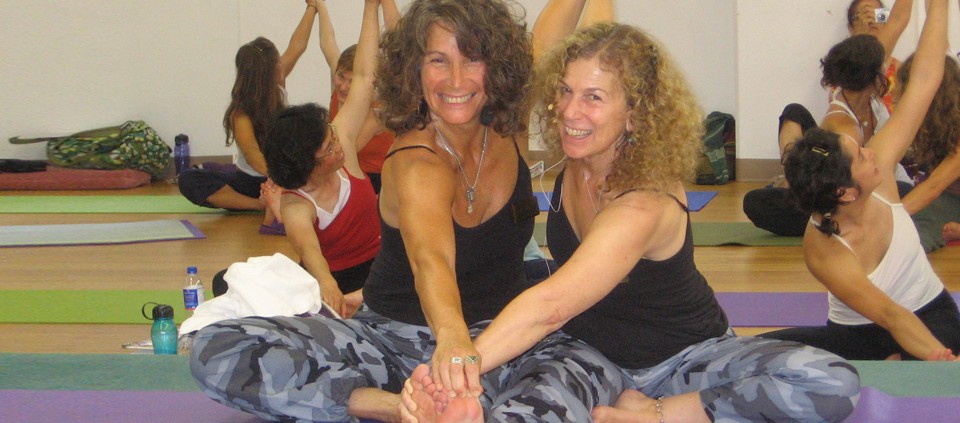The Gifts of Yin Yoga: A Balance to an Active Life and Practice

by Brahmani Liebman and Jashoda Edmunds
What if you could listen to dharma teachings and receive the benefits of being in a yoga posture?
What if you could calm the nervous system and enhance your energy at the same time?
What if you could practice meditation and yoga simultaneously?
What if you could find a practice that was both contemplative and energy enhancing?
What if you could nourish the connective tissues, joints, and bones while also accessing the deeper parts of your mind?
What if your active practice could be even more fluid?
What if you were able to sit with even more comfort and ease in your meditation practice?
What if you had a practice that complemented Kripalu Yoga in its invitation to grow in tolerance and go beyond your self-limiting beliefs?
Welcome to Yin Yoga!
We first discovered Yin Yoga at a Yoga Journal Conference in Manhattan around the year 2000. That class, taught by Sarah Powers, inspired each of us. She modeled how to marry our two loves of meditation and yoga practice. We both observed a more open body and quieter mind, as well as a depth experienced through the integration of the dharma (specifically yoga, Buddhism, and psychospiritual inquiry) while holding the postures. We had been students of vipassana meditation for a number of years, and this gave us each freedom to include and share all that has inspired us in our practices and studies.
As we all know, the tendency in the Western culture is to overschedule, keep busy, do more, and go, go, go. We see it happening from early childhood on throughout life. We even see it manifesting in the world of yoga and meditation. Yin Yoga offers the possibility to stop, look, and listen. Yin Yoga asks us to keep being here in this moment, because it is the only place that life is happening. It's the perfect complement to our active lives and to a more active yoga.
The three basic tenets of Yin Yoga are
- Practice appropriate pressure: Come to an edge of sensation that is neither neutral nor alarming.
- Remain muscularly passive: Come into the posture while allowing the muscles to be soft and passive, so the prana can move through the body to nourish the connective tissue, joints, and bones.
- Stay awhile: Longer holdings of three to five minutes enable you to grow the capacities beyond the mind and the self-limiting concepts of what we think. This steady pressure allows prana to accumulate and flow.
Placing the body in a posture, Yin style, invites an open receptivity to inspiring teachings. This can happen when practicing in a class or on your own.
As a Yin Yoga teacher, you have the opportunity to share relevant and meaningful teachings that inform, inspire, and light you up. When you impart teachings during the Yin portion of your classes, you can carry that theme throughout class and into life.
How and when might you use Yin Yoga? It can be practiced on its own, as well as part of a yin (passive)/yang (active) practice. To receive the greatest benefit to the connective tissues, joints, and bones, it’s best to practice before warming the muscles in an active practice.
One of our favorite things about Yin Yoga is that it can be practiced upon waking, right in the comfort of your own bed. Place your body in a Yin pose; set the timer for three to five minutes; breathe long, slow Ujjayi breaths; and allow the pose to prepare the body and mind for sitting meditation. In fact, preparation for meditation is one of the primary benefits of Yin Yoga.
Other times to practice might be before bed or in the middle of the night, to allow the nervous system to settle, or anytime an active practice is not appropriate (such as during a healing process).
Wide-Knee Child’s Pose, Yin Style
- Begin in Table pose, with your knees under your hips and your hands under your shoulders.
- Spread the knees wide and bring the feet toward each other.
- Press the hips back and as close as possible to the feet and meet the appropriate edge.
- Come to rest on the elbows and spread them wide, placing one hand on the other and resting your head on your hands. Keep a gentle press into the hands or elbows to keep the weight back in the hips and out of the knees.
- Stay in the pose for three to five minutes.
To release,
- Press into your hands
- Bring your buttocks off your heels
- Lift one knee at a time and bring it back under the hips
- Press back into Child’s pose
- Pause and feel the effects.
For a variation on the posture, try either beginning in Child’s pose; extending the arms overhead; or resting the chest on a folded blanket or bolster.
Experiment with this practice and make it your own!
Find out about upcoming programs with Brahmani Liebman and Jashoda Edmunds
© Kripalu Center for Yoga & Health. All rights reserved. To request permission to reprint, please e-mail editor@kripalu.org.